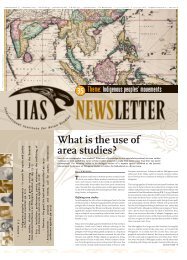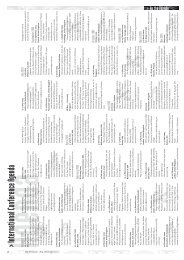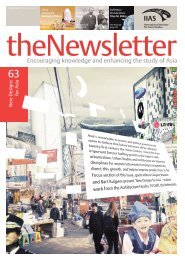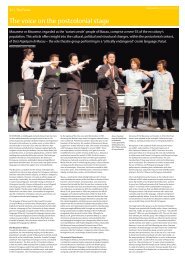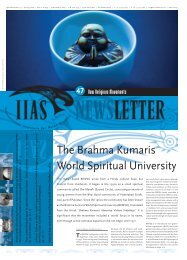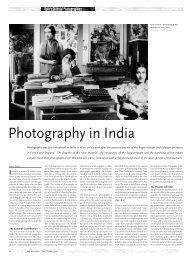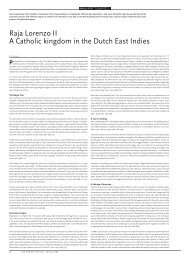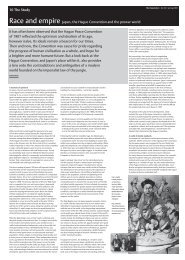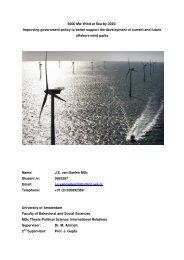Sex, love and revolution - IIAS
Sex, love and revolution - IIAS
Sex, love and revolution - IIAS
You also want an ePaper? Increase the reach of your titles
YUMPU automatically turns print PDFs into web optimized ePapers that Google loves.
T H E M E W o m e n W a r r i o r s<br />
The story of Hua Mulan – a woman successfully masquerading as a man within the imperial military for over a decade – has entranced<br />
<strong>and</strong> intrigued generations of Chinese. Since the Northern Wei dynasty (386-534), when the original poem The Ballad of Mulan (Mulan shi) 1<br />
first appeared, Hua Mulan’s remarkable adventures have been a recurring theme in both elite <strong>and</strong> popular cultural forms. Louise Edwards<br />
examines the various renditions of Hua Mulan’s story <strong>and</strong> discovers that China’s most famous woman warrior was redolent with sexual<br />
significance.<br />
Re-fashioning the warrior<br />
Hua Mulan:<br />
Changing norms of sexuality in China<br />
Louise Edwards<br />
The continued popularity of Hua Mulan’s<br />
tale derives in part from its flexibility <strong>and</strong><br />
its redactors’ enthusiasm to make adjustments<br />
to the description, plot <strong>and</strong> conclusion<br />
as suits their needs. As Wu Pei-Yi<br />
aptly put it, “She was, <strong>and</strong> still is, amenable<br />
to all forms of fantasizing <strong>and</strong> manipulation”.<br />
2 There is not one single coherent<br />
Hua Mulan narrative, but many. However,<br />
the sustained popular interest in the story<br />
over 1500 years (Mulan has been the subject<br />
of poetry, drama, opera <strong>and</strong> more<br />
recently film, television series <strong>and</strong> video<br />
games) also emerges in large part from its<br />
foregrounding of a foundational problem<br />
in China’s ever evolving social order: the<br />
governance of sexual morality between<br />
<strong>and</strong> among men <strong>and</strong> women. 3<br />
In dressing as a man <strong>and</strong> undertaking<br />
masculine life-roles, Hua Mulan challenges<br />
long-held expected differentiation<br />
between the behaviour of men <strong>and</strong> women.<br />
Her departure from the feminine domestic<br />
realm to enter the masculine world of warfare<br />
is at the core of her ongoing appeal.<br />
‘Mulan bidding her parents farewell’. From Chu Renhu (fl. 1675-1695). Sui<br />
This aspect of her appeal exp<strong>and</strong>ed as practices<br />
of sex-segregation <strong>and</strong> the sexualisation<br />
of female virtue increased through the<br />
Ming (1368-1644) <strong>and</strong> especially the Qing<br />
(1644-1912) dynasties. In the 20th century,<br />
reformist intellectuals’ <strong>and</strong> creative artists’<br />
embracing of feminist principles as<br />
an emblem of modernity meant Mulan’s<br />
venture into the male world was invoked<br />
as evidence of an early Chinese woman’s<br />
challenge to sex-segregation. However,<br />
while invalidating sex-segregation they<br />
were still unable to entirely un-couple<br />
female virtue <strong>and</strong> sexual chastity.<br />
Taboos on body bits<br />
The sexualisation of the Mulan body has<br />
evolved over time as the different ‘female<br />
body bits’ move in <strong>and</strong> out of erotic focus.<br />
In the Tang, eyebrows set upon a delicate<br />
face featured as signifiers of Mulan’s feminine<br />
desirability <strong>and</strong> cosmetics served as<br />
synecdoches for the intimacy of the private,<br />
feminine boudoir in poems on Mulan<br />
by Bai Juyi (772-846) <strong>and</strong> Du Mu (803-852).<br />
In the Ming, Xu Wei’s (1521-93) popular<br />
Ming drama The female Mulan replaces her<br />
father in the military (Ci Mulan ti fu cong<br />
Tang yanyi. (Narrative of the Sui <strong>and</strong> the Tang). Full text version available from<br />
Project Gutenberg. www.gutenberg.org/files/23835/23835-0.txt<br />
jun) reminds readers of her erotic appeal<br />
through extensive references to Mulan’s<br />
feet - a highly eroticised part of the female<br />
body at this time. Xu’s play describes<br />
Mulan painfully unbinding her feet in<br />
order to pass as a man. Mulan’s mother<br />
also draws the audiences’ attention to feet<br />
by commenting that she finds her daughter’s<br />
feet “big” <strong>and</strong> “strange”. The original<br />
Ballad of Mulan made no reference to footbinding<br />
because the practice did not exist<br />
in the Northern Wei, but its anachronistic<br />
inclusion in the Ming versions of her story<br />
was important because the foot motif<br />
reminded the audience of the sexualised<br />
<strong>and</strong> eroticised nature of women’s bodies.<br />
Mulan’s 20 th century re-creators used<br />
other parts of the body to remind audiences<br />
of her sexuality. They build tension<br />
around comic references to the upper body<br />
<strong>and</strong> breasts. In the 1964 Huangmei diao<br />
opera-film version of her story, directed by<br />
Yue Feng, Mulan resists receiving medical<br />
attention for her shoulder wound using<br />
feeblearguments like “Since I was small I<br />
haven’t liked to remove my clothes”. The<br />
other soldiers comment that it is strange<br />
The beautiful <strong>and</strong> filial Mulan’. From Ma Tai (1886-1939). Meiren baitai<br />
huapu. (Pictorial collection of myriad beauties), in Ma Tai. rpt. 1982. Ma<br />
Tai hua bao (Treasury of Ma Tai’s pictures). Shanghai: Guji shudian<br />
that a “Big tough guy doesn’t like taking<br />
his clothes off”. In the end, a compromise<br />
is reached <strong>and</strong> they cut an opening<br />
in the clothing around the wound without<br />
exposing the rest of her body. Wong Hoksing’s<br />
1961 Cantonese Opera film version<br />
includes a similar upper arm injury, which<br />
is treated only by carefully rolling up the<br />
sleeve, but the soldiers that work on the<br />
injury rather salaciously discuss the unusual<br />
smoothness of his/her skin. In the<br />
1999 Yang Peipei directed multi-episode<br />
television drama version, Mulan’s breasts<br />
are a constant source of difficulty for her<br />
disguise as she avoids her fellow soldiers<br />
touching her chest in multiple comic<br />
scenes of celebratory group hugs <strong>and</strong><br />
upper body injuries.<br />
Accompanying the shifting, disaggregated,<br />
corporeal erotic is the evident anxiety<br />
produced by the dismantling of sex-segregation<br />
practices in the 20 th century.<br />
Mulan allows audiences to touch upon<br />
the central problems of feminine sexuality<br />
<strong>and</strong> female sexual virtue; particularly<br />
the latter’s vulnerability to the dangers<br />
posed by a woman’s proximity to men.<br />
The most remarkable example of the anxiety<br />
produced by the risk to norms of virtue<br />
posed by ‘women in public’ emerges from<br />
the 1939 version directed by Bu Wancang.<br />
The film was released in the middle of the<br />
War of Resistance against Japan where ‘the<br />
ravaged woman’ routinely symbolised the<br />
ravaged nation in film, fiction <strong>and</strong> art. It<br />
commences with Mulan being surrounded<br />
by hoodlums attempting to steal the rabbits<br />
she has just caught. The sexual threat<br />
posed by the gang is clear as the leader<br />
touches her with his arrows, moving from<br />
her lips, face, arm <strong>and</strong> eventually thwacking<br />
her buttocks. The movement around<br />
her body suggesting that no part of her<br />
body was safe <strong>and</strong> every part was an eroticised<br />
site. Moreover, this sexualised body<br />
is a vulnerable body. Others in the group<br />
warn her to behave because he “still hasn’t<br />
taken a wife” suggesting that he might like<br />
to ‘take’ Mulan. To escape this threatening<br />
gang Mulan uses her wit <strong>and</strong> cunning.<br />
Later in the film, audiences are reminded<br />
of the threat posed by soldiers to women<br />
when the invading forces capture the comm<strong>and</strong><br />
post <strong>and</strong> rush through carrying off<br />
the screaming <strong>and</strong> terrified women as<br />
booty.<br />
The eroticisation of privacy marks the<br />
maintenance of the female body as rich<br />
in sexuality. Tang dynasty (618-907) readers<br />
view Mulan’s boudoir <strong>and</strong> imagine her<br />
painstaking care in applying cosmetics<br />
<strong>and</strong> painting her eyebrows in poems by Bai<br />
Juyi <strong>and</strong> Du Mu. The invocation of Mulan<br />
amidst her personal toilette provided male<br />
readers of refined Tang poetry a glimpse<br />
into the female boudoir. The Ming-Qing<br />
eroticisation of the secret viewing of<br />
women urinating, discussed at length by<br />
R. Keith McMahon, makes an appearance<br />
in the Xu Wei version of the Mulan story. 4<br />
He entertains his Ming audiences with a<br />
humorous discussion of Mulan’s toileting<br />
problems. One of Mulan’s comrades<br />
comments, “It’s very strange that Brother<br />
Hua never lets anyone see him urinate”.<br />
The play devotes much space to explain<br />
Mulan’s ability to avoid being seen urinating.<br />
In the late 20 th century, when the<br />
evacuation of bodily waste is regarded<br />
as prurient <strong>and</strong> scatological, rather than<br />
erotic <strong>and</strong> amusing, such matters are<br />
ignored. Instead, in keeping with the traditions<br />
of eroticisation of spying on ‘bathing<br />
beauties’, we see repeatedly Mulan’s<br />
difficulties in bathing. This is a frequent<br />
feature of Yang Peipei’s 1999 television<br />
series. For example, Mulan explains to<br />
her much-amused father how she avoids<br />
being caught naked - including swimming<br />
at night in icy cold rivers <strong>and</strong> the audience<br />
is treated to comic episodes where she is<br />
nearly discovered naked in baths <strong>and</strong> bathrooms,<br />
avoiding detection only by fortuitous<br />
twists in plot.<br />
The mobility of ‘the erotic’ around the body<br />
<strong>and</strong> the changing notion of the private as<br />
feminised <strong>and</strong> sexualised over the course<br />
of time reveal the importance of sexuality<br />
to the ongoing appeal of the Mulan story.<br />
She is far from the “non-sexual”, “defeminized”<br />
women warrior that Cai Rong<br />
argues dominates the Wuxia (Martial Arts)<br />
literary <strong>and</strong> film genres of recent years. 5<br />
She is a filial daughter, but within that<br />
pious rubric she has also allowed generations<br />
of readers <strong>and</strong> viewers to fantasise<br />
on the problems of human sexuality <strong>and</strong><br />
female sexual virtue.<br />
Cross-dressing <strong>and</strong> homo/<br />
hetero-sexual desire<br />
Unlike Hua Mulan’s soldier comrades in<br />
arms, readers of the original ‘Ballad’ <strong>and</strong><br />
the subsequent audiences of dramatic<br />
<strong>and</strong> television renditions are drawn into a<br />
conspiracy of cross-dressing. Prior to the<br />
20 th century, the narrative tension this special<br />
knowledge generates revolves around<br />
the risk Mulan takes in attracting official<br />
displeasure, execution, shame or abuse<br />
during her masquerade as a man. However,<br />
in the 20 th century, in keeping with<br />
the exp<strong>and</strong>ing disapproval of homoerotic<br />
<br />
I I A S N E W S L E T T E R # 4 8 S u m m e r 2 0 0 8



